Jazz Guitarists
Les
Paul "The Wizard of Waukesha" (Inventor and Developer of the Electric
Guitar)
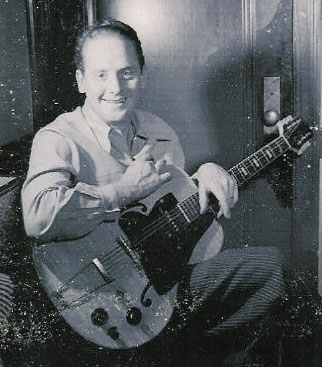 Lester William was
born in Waukesha, Wisconsin on June 9, 1915 to parents George and Evelyn (Stutz)
Polsfuss. Les' mother was related to the Stutz Bearcat automobile and Blatz beer
people. Les says his greatest God-given gifts are perfect pitch, a love for
music with the ability to learn it quickly, and the curiosity and persistence of
an inventor who wants to know "how things tick". His first professional job, as
"Red Hot Red," was as a guitarist and harmonica player when he was just
thirteen. One fateful night, while playing to an outdoor crowd, a listener in
the back complained that Les' voice could not be heard. To accommodate those
farthest away, Les attached his mother's radio to the family's telephone
mouthpiece creating a public address system. Again a critic voiced that his
guitar could not be heard. So Les "borrowed" his father's radio, the other end
of the telephone, and the needle from the family record player. Jamming the
needle into the guitar bridge and joining the other components, Les' guitar and
voice were now heard by all. Les actually created a stereo system, however with
some feedback and acoustic vibrations. Les experimented by stuffing clothes and
plaster of paris in the guitar to dampen the unwanted acoustic vibrations. The
plaster worked but the guitar was too heavy! His final experiment was attaching
a guitar string to a hinge placed at the end of a railroad track. The sound was
perfect. When Les showed his mother his accomplishment she replied, "You'll
never see Gene Autry (the most popular singing cowboy at the time), carrying
that thing around". So he settled on using a 4x4 block of wood attached to an
Epiphone neck. When the audience paid no attention to his playing because the
instrument was too strange, he realized that "people hear with their eyes." To
compensate for this Les attached two non-functional "wings" to the 4x4 so it
looked like a normal guitar. The fans loved the sound! Les has donated his first
practical solid-body electric guitar (1941), to The Country Music Hall of Fame
in Nashville, Tennessee where it is on permanent display. Les' solid-body
electric guitar concept, however, was not appreciated by guitar makers until one
was successfully marketed by a California neighbour, Leo Fender who was into
electronics. Then the Gibson Guitar Company contacted Les who was called "the
guy with the pickups on the broom handle."
Lester William was
born in Waukesha, Wisconsin on June 9, 1915 to parents George and Evelyn (Stutz)
Polsfuss. Les' mother was related to the Stutz Bearcat automobile and Blatz beer
people. Les says his greatest God-given gifts are perfect pitch, a love for
music with the ability to learn it quickly, and the curiosity and persistence of
an inventor who wants to know "how things tick". His first professional job, as
"Red Hot Red," was as a guitarist and harmonica player when he was just
thirteen. One fateful night, while playing to an outdoor crowd, a listener in
the back complained that Les' voice could not be heard. To accommodate those
farthest away, Les attached his mother's radio to the family's telephone
mouthpiece creating a public address system. Again a critic voiced that his
guitar could not be heard. So Les "borrowed" his father's radio, the other end
of the telephone, and the needle from the family record player. Jamming the
needle into the guitar bridge and joining the other components, Les' guitar and
voice were now heard by all. Les actually created a stereo system, however with
some feedback and acoustic vibrations. Les experimented by stuffing clothes and
plaster of paris in the guitar to dampen the unwanted acoustic vibrations. The
plaster worked but the guitar was too heavy! His final experiment was attaching
a guitar string to a hinge placed at the end of a railroad track. The sound was
perfect. When Les showed his mother his accomplishment she replied, "You'll
never see Gene Autry (the most popular singing cowboy at the time), carrying
that thing around". So he settled on using a 4x4 block of wood attached to an
Epiphone neck. When the audience paid no attention to his playing because the
instrument was too strange, he realized that "people hear with their eyes." To
compensate for this Les attached two non-functional "wings" to the 4x4 so it
looked like a normal guitar. The fans loved the sound! Les has donated his first
practical solid-body electric guitar (1941), to The Country Music Hall of Fame
in Nashville, Tennessee where it is on permanent display. Les' solid-body
electric guitar concept, however, was not appreciated by guitar makers until one
was successfully marketed by a California neighbour, Leo Fender who was into
electronics. Then the Gibson Guitar Company contacted Les who was called "the
guy with the pickups on the broom handle."
Les applied for his first patent, "Combined Bridge and Tailpiece for Stringed
Instruments", on July 9, 1952, a one pickup design which was granted on March
13, 1956, #2,737,842. A patent filed by Gibson president, the late Theodore M.
McCarty, on Jan. 21, 1953, "Stringed Musical Instrument of the Guitar Type And
Combined Bridge And Tailpiece Therefore", was granted on Aug. 2, 1955,
#2,714,326. This two pick-up design appears to be the basis of the Les Paul
model guitars in which Les says he had much input.
Back in 1946, Les'
mother commented that she heard him on the radio on a particular night. Les
explained that it wasn't him as he was on stage playing back-up guitar with the
Andrew Sisters. Apparently someone was copying his style. Les was so dejected
that someone could copy him good enough to fool his mother that he quit the
Andrew Sisters and devoted the
next two years in secret experiments toward developing his unique sound.
Hundreds of multiple-disc recording experiments, some with delay, reverb, echo
and other electronic techniques, were made. Then at a party one night he quietly
slipped in his new recording of "Lover" (1948). History again was made, and a
contract with Capitol Records quickly followed. Capitol asked Les what this new
sound should be called. Les keeping it simple, said "The New Sound", and that's
how his records were marketed! After World War II, a Newark, New Jersey
electronics engineer, Colonel Richard Ranger, showed Les a tape recorder which
he located in a German military electronics laboratory. Les then informed Bing
Crosby of the machine since Bing wanted to record away from the studio and have
more time to play golf. When Les assured Crosby that the device would work, Bing
said he wanted 50. The Rangertone Electronics Company could not mass-produce the
recorders fast enough so the idea was submitted to the Ampex Corporation. Bing
Crosby put up the capital and gave one recorder to Les. On the road to Chicago
with Mary Ford (nee Colleen Summers) and the new recorder, Les thought that if
he could put in one additional recording head he could do sound-on-sound
recordings anywhere. So Les called Ampex and said he burned out the recording
head and could they send another. The additional head was installed by a
machinist named Mr. Goodspeed and it worked on first try. No more was a studio
needed for him and Mary. Then to solve the problem of recording with other
musicians who were not present, Les conceived the idea of recording on eight
separate tracks then blending them together. He consulted Ampex again (1952) and
they agreed to build him one at his cost. Les did not seek a patent on this
concept or the "Sel-Sync" idea (1956-60), which made the now-famous multi-track
possible. On Jan. 30, 1962 Les was granted patent # 3,018,680, "Electrical
Musical Instrument", and on Apr. 3, 1973, # 3,725,561 "Method of Electrically
Reproducing Music and Improved Electrical Pickup
for Practicing the Same". Both were for improved
pickups. He is presently working on ten electronic pickup modifications, in as
many guitars, chasing after his quest of "the perfect sound." Not bad for a "tinkerer"
wouldn't you say? Les was inducted into the New Jersey Inventor's Hall of Fame
in 1996. On February 20th 2001, Les received his 5th Grammy, for his technical
achievements, from the National Academy of Recording Arts & Sciences.
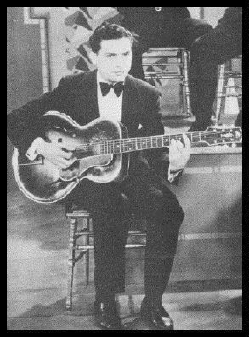 Eddie
Lang 1904-1933
Eddie
Lang 1904-1933
Eddie's birth name was Salvatore Massaro. He
changed his name when he started his career performing, an Italian name was a
disadvantage at that time. He was a proficient blues player and recorded a few
blues records under the name "Blind Wille Dunn."
Eddie is most remembered for his work with
violinist Joe Venuti. Lang and Venuti were considered the American equivalent of
Europe's Django Reinhardt and Stephane Grappelli.
Lang was a master of improvisation and had
amazing facility on the guitar. His single note soloing was intricate,
expressive and blues influenced. His chordal playing was also impressive,
changing chords on every beat and swinging hard.
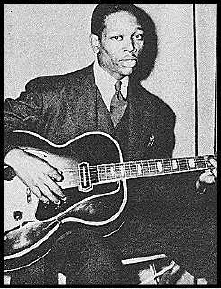
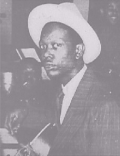 Charlie
Christian 1916-1942
Charlie
Christian 1916-1942
Charlie changed the role of the guitarist in the
jazz band. Charlie was the first person to become proficient on the electric
guitar.
Christian worked with several big bands but is
most remembered for his work with Benny Goodman. Benny featured Charlie as a
soloist and not a rhythm player. Charlie is responsible for putting the electric
guitar on the musical map.
Christian's improvising was impeccable. He swung
like a horn player and utilized many melodic devices that Bird used. If
Christian had lived he would have been one of the musicians credited with
creating Bebop
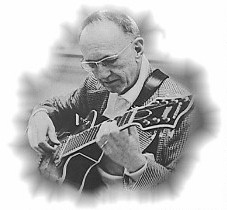
George Van Eps -
George was a quiet legend among jazz guitarists,
one who as far back as the 1930s pioneered a harmonically sophisticated
chordal/lead style that was eclipsed in influence by the single-string
idioms of Charlie Christian and Django Reinhardt. Yet Van Eps, like his
brassy colleague Les Paul, also stood apart from them as an iconoclastic
inventor, designing a seven-string guitar in the late 1930s that adds an
extra bass string. Thus, Van Eps was able to play bass lines simultaneously
with chords and lead solos, a jazz equivalent of fingerpicking country
guitarists like Merle Travis and Chet Atkins. Van Eps puckishly referred to
his style of playing as "lap piano," and his seven-string guitar has been
adopted by a select few figures like Howard Alden and Bucky and John
Pizzarelli.
Van Eps came from a talented musical family; his father Fred was a famous
master of the ragtime banjo and a sound engineer, his mother played the
piano, and he had three brothers, Bobby, Freddy and John, who were also
professional musicians. Self-taught on the banjo, Van Eps began playing
professionally at 11, and after falling under the influence of Eddie Lang
two years later, he learned the guitar well enough to play alongside Lang
for six months as a teenager. From there, Van Eps worked with Freddy Martin
(1931-33), Benny Goodman (1934-35) and Ray Noble (1935-36) before moving to
Hollywood to become a freelance musician, author of a how-to guitar book,
and instrument designer. After returning to Noble in 1940-41, Van Eps worked
in his father's recording lab for two years before returning to the
freelance arena, where, among other things, he worked for Paul Weston and
took part in the 1950s film and TV series Pete Kelly's Blues.
Van Eps only made a handful of recordings as a leader or unaccompanied
soloist, including Mellow Guitar (Columbia, 1956) and My Guitar, George Van
Eps' Seven-String Guitar and Soliloquy for Capitol in the late 1960s. A bout
of serious illness in the early 1970s, plus a 1977 hand injury that resulted
in three broken fingers, reduced his activities. However, Van Eps returned
to the studio in 1991 for the first of three exquisite duo albums for
Concord Jazz with his former student Howard Alden, mixing venerable
standards with a few Van Eps originals, and he shared a solo guitar album
with Johnny Smith in 1994. George created the
first 7-string jazz guitar in 1938. He took his beloved Epiphone guitar to
the Epiphone factory in New York and had the neck, tailpiece, and bridge
replaced to accommodate an extra string, a low A tuned a perfect fifth below
the low E string. Thus the seventh string did not alter the standard tuning
of the instrument but enhanced it by adding the rich tones of the bass
register. The 7th string opened up many opportunities for building walking
bass lines while simultaneously comping chords. It also expanded the range
of the instrument giving George a richer, fuller sound when playing solo
guitar. Van Eps called it his "lap piano". Even in his 80s, he remained an eloquent exponent
of easygoing modern swing, dying of pneumonia on November 29, 1998.
George Van Eps and
Howard Alden 1993
 Johnny Smith
Guitarist Johnny
Smith's career spans the decades of the 1940's through the 1990's. From the very
beginning of his musical career he influenced the playing of other guitarists.
In fact, other guitarists mention Smith almost as often as they mention Charlie
Christian as a major influence on their playing. And today, in the late 1990's
players still feel and respond to the influence of Johnny Smith. In the preface
to Steve Silverman's 1998 transcriptions of Johnny Smith Guitar Solos he
acknowledges that Johnny Smith has been "a source" of inspiration and influence
on guitarists as diverse as Pat Martino and Chet Atkins.
Johnny Smith
Guitarist Johnny
Smith's career spans the decades of the 1940's through the 1990's. From the very
beginning of his musical career he influenced the playing of other guitarists.
In fact, other guitarists mention Smith almost as often as they mention Charlie
Christian as a major influence on their playing. And today, in the late 1990's
players still feel and respond to the influence of Johnny Smith. In the preface
to Steve Silverman's 1998 transcriptions of Johnny Smith Guitar Solos he
acknowledges that Johnny Smith has been "a source" of inspiration and influence
on guitarists as diverse as Pat Martino and Chet Atkins.
Even before he hit the New York jazz scene in the late 1940's
Johnny Smith was setting an example of great musicianship and brilliant jazz
guitar playing. There is a story that Lou Mecca tells about his first meeting
with Johnny Smith when Smith was playing trumpet in the army band. This story,
told to Just Jazz Guitar Magazine, May 1995, exemplifies the influence Johnny
Smith has had on other guitar players. Mecca visited Johnny in the barracks at
Valley Forge, VA in the late 1940's. Their discussion immediately went to
guitars and Johnny offered his guitar to Mecca and asked him to play something.
Lou Mecca played something he knew and Johnny said he like it. Then Johnny
proceeded to play several startling pieces including Rhapsody In Blue.
Mecca ends this memory by commenting, "I then realized I was in the presence of
one of the greatest guitarists of all time ... ".
Like most of the great jazz guitarists, Johnny Smith started out
as an excellent musician first. When he arrived in New York in the late 1940's
he moved as easily on to 52nd as he did into playing with the philharmonic. He
took up a staff position with NBC and it was while there that he recorded
Moonlight in Vermont
with Stan Getz. This recording established Johnny Smith
as a major talent and in a flurry of recording activity he produced some of the
most important recordings in jazz guitar history.
During his tenure at Roost Records, under the auspices of Teddy
Reig, he produced a long list of significant recordings that include the great
quartet recordings
The Johnny Smith Quartet, and
The Sound of The
Johnny Smith Guitar
among others. Also, during this period he made the
Man With The Blue Guitar.
This album, unusual for its time, has probably
been transcribed more than any other Johnny Smith recording. Then there was the
Johnny Richards production
Annotations of The Muses,
on which Johnny
Smith displays everything that made him a great musician and an extraordinary
guitar player.
Johnny Smith retired from the jazz scene in the 1960's to Colorado where he
opened a music store. He continued to play in local nightclubs and made a
recording with some local musicians (Reminiscing) that showed he had lost
none of the signature Johnny Smith style or technique. His last published
recorded work was the Concord Records CD
Legends, in 1994. This last
recording like
The Man With The Blue Guitar
is made up of solo guitar
pieces that capture the essence of the Johnny Smith guitar.
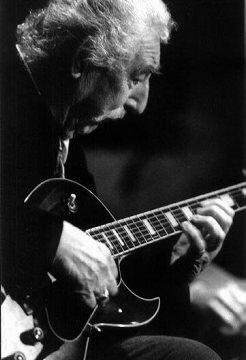 Al Viola
(1919) grew up in Brooklyn, New York, and got his start
playing the guitar by learning the basics from his mother and older brother. As
a teenager he listened and learned from to the work of Charlie Christian and
Oscar Moore. In 1941 he entered the army and was assigned to play in the army
band, in Sacramento, CA. There he met a young piano player, Page Cavanaugh, and
the Page Cavanaugh Trio was formed. When their army duty was over, the Page
Cavanaugh Trio moved to Los Angeles where they began playing local clubs and
recording. A number of Trio recordings come out of this period on the RCA
Victor, Signature and ARA labels. These early recordings always included a nice
solo by Al Viola and they are a good place to start listening to the guitar of
Al Viola, if you can find the recordings. In 1946, the Page Cavanaugh Trio
accompanied Frank Sinatra to New York where they played nightly behind Sinatra
at the Waldorf Astoria Hotel. During this same period the Cavanaugh Trio made a
couple of recordings with Sinatra (That's How Much I Love You and You
Can Take My Word For It Baby) both of which have enjoyed a broad
distribution due to Sinatra's popularity. And, like the Cavanaugh Trio
recordings, those with Sinatra included a nice solo by Al Viola. Later that same
year Al Viola took up residence again in Los Angeles and settled into the music
scene there. He played with Bobby Troup and Buddy Collette, toured and recorded
with Julie London and played in the great Harry James Band of that period. He
was also in high demand in the recording and television studios where he worked
with Ray Anthony and Steve Allen. During this time Al Viola began playing with
Frank Sinatra again, and this association continued for many years. Al Viola
took up the classical guitar in the late 1940's and in the next three decades
made the solo guitar recordings for which he is probably best known; Solo
Guitar, Guitar Lament and Alone Again. These recordings showed the
remarkable versatility and musicianship of Al Viola. And, when taken in the
total context of 50 plus years of music making, they completed the picture of a
musician who was an early pioneer of the electric guitar, was able to swing with
the best of them (check out his comping clinic on Riviera from the 1958
Flute In Hi-Fi), provided backup for the best singers of the day, and
could stay in the background providing solid rhythm for other soloists.
Al Viola
(1919) grew up in Brooklyn, New York, and got his start
playing the guitar by learning the basics from his mother and older brother. As
a teenager he listened and learned from to the work of Charlie Christian and
Oscar Moore. In 1941 he entered the army and was assigned to play in the army
band, in Sacramento, CA. There he met a young piano player, Page Cavanaugh, and
the Page Cavanaugh Trio was formed. When their army duty was over, the Page
Cavanaugh Trio moved to Los Angeles where they began playing local clubs and
recording. A number of Trio recordings come out of this period on the RCA
Victor, Signature and ARA labels. These early recordings always included a nice
solo by Al Viola and they are a good place to start listening to the guitar of
Al Viola, if you can find the recordings. In 1946, the Page Cavanaugh Trio
accompanied Frank Sinatra to New York where they played nightly behind Sinatra
at the Waldorf Astoria Hotel. During this same period the Cavanaugh Trio made a
couple of recordings with Sinatra (That's How Much I Love You and You
Can Take My Word For It Baby) both of which have enjoyed a broad
distribution due to Sinatra's popularity. And, like the Cavanaugh Trio
recordings, those with Sinatra included a nice solo by Al Viola. Later that same
year Al Viola took up residence again in Los Angeles and settled into the music
scene there. He played with Bobby Troup and Buddy Collette, toured and recorded
with Julie London and played in the great Harry James Band of that period. He
was also in high demand in the recording and television studios where he worked
with Ray Anthony and Steve Allen. During this time Al Viola began playing with
Frank Sinatra again, and this association continued for many years. Al Viola
took up the classical guitar in the late 1940's and in the next three decades
made the solo guitar recordings for which he is probably best known; Solo
Guitar, Guitar Lament and Alone Again. These recordings showed the
remarkable versatility and musicianship of Al Viola. And, when taken in the
total context of 50 plus years of music making, they completed the picture of a
musician who was an early pioneer of the electric guitar, was able to swing with
the best of them (check out his comping clinic on Riviera from the 1958
Flute In Hi-Fi), provided backup for the best singers of the day, and
could stay in the background providing solid rhythm for other soloists.
 In
the 1940's
In
the 1940's
Tal (Talmage) Farlow
was in New York beginning to influence and capture the imaginations of jazz
guitarists and jazz fans with his unique sound and style. He made a number of
recordings with Buddy deFranco, Artie Shaw and Red Norvo before making a series
of recordings under his own name in the 1950's. Those recordings included
Tal, This is Tal Farlow, The Tal Farlow Album and Autumn in New York.
It was this series of recordings that established Tal Farlow as one of the
greatest jazz guitarists of all time.
Farlow retired to Seabright, New Jersey after these
recordings were made and took up his old occupation of sign painting. He
continued to play in the local clubs in and around Seabright and from time to
time he was enticed into making a recording. Concord Jazz brought Farlow out of
"retirement" in the late 1970's to make a series of recordings that are as
astounding in their own way as those made in the 1950's. In fact, these two sets
of recordings offer a unique glimpse into the incredible style of this amazing
guitarist. Tal had enormous hands that would dwarf most that wish to be compared
for size. Catch the Biography film and the resultant recoding if you can.
Tal
Farlow Film Excerpts
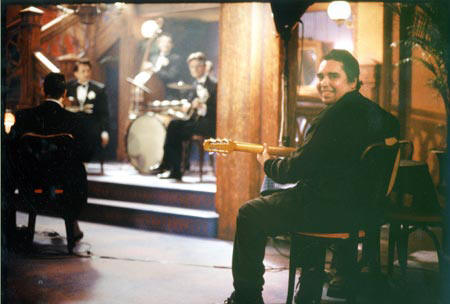 Howard
Alden - Guitarist
Howard
Alden - Guitarist
Howard Alden guitar solos from the Woody Allen film "Sweet and Low Down" based on
fictional Emmett
Ray's life in the 30's:
1. I'll See You in My Dreams 2. I'm Forever Blowing Bubbles 3. Limehouse
Blues 4. Wrap Your Troubles in Dreams 5. Just a Gigalo 6. Sweet Georgia
Brown 7. Unfaithful Woman 8. "E" is for Emmet 9. Shine 10. 12th Street Rag
10. 3:00 AM Blues 11. It Don't Mean a Thing (if it Ain't Got That Swing) 12.
Old Fashioned Love
The guitar
playing in the movie is actually by Howard Alden. You will want to own the
soundtrack. Alden taught Sean Penn to play the guitar, in lessons so
successful that Allen's camera never has to cheat: We hear Emmet
Ray and we see Emmet Ray's fingers, and there is never reason to doubt that
Penn is actually playing the guitar.
Howard Alden belongs to a small, elite
group of the very best jazz guitarists in the world." -- Johnny Smith
Howard Alden & George Van Eps 1993
Ed Bickert
Al
Di Meola
John
Scofield
Pat
Metheny
Malcolm
MacFarlane
Lee
Ritenour
http://www.youtube.com/watch?v=ma_nL3lx8d8&mode=related&search=
Joe Pass
Wes Montgomery - Round
Midnight
Wes Montgomery - Nica's
Dream
George Benson - Affirmation